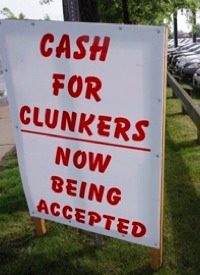
The federal $3 billion “Cash for Clunkers” program promoted by the Obama White House last summer cost an average of $24,000 per additional car sold, according to an analysis by automotive consumer researcher Edmunds.com. The White House has responded with a blistering attack disputing the finding.
For that price, the federal government could have purchased the 125,000 cars outright at manufacturer suggested retail prices, such as a Ford Fusion, Focus or even a Mustang, and then handed each of the recipients an additional bonus check averaging the Cash-for-Clunkers subsidy of $4,000. Or they could have bought every one of those 125,000 people a Smart car and then given them a check for $6,000.
Edmunds.com analyzed the plummeting auto sales in the United States market during September and concluded that the program generated only 125,000 additional automobile sales over and above what would have been purchased by consumers anyway. Edmunds.com then calculated the cost of each new car by dividing the program’s $3 billion funding by 125,000 cars and found the cost to be $24,000 for each additional car sold. The average purchase price of a new car under the program was only $25,000, according to Edmunds.
The White House responded by describing the Edmunds analysis as coming from “Mars,” adding that:
This faulty assumption leads Edmunds to a conclusion that is at odds with many independent analyses: Edmunds assumption that more than 80% of the payback from Cash for Clunkers would occur in 2009 isn’t how many mainstream analyses … approach the problem.
The problem with the White House complaint is that the “mainstream analyses” cited by the White House consisted entirely of old predictions, none of which had the benefit of industry September sales data. In other words, the White House “mainstream analyses” were based upon predictions rather than actual data. And the same President’s Council of Economic Advisors’ study cited by the White House press office in its complaint about Edmunds even admitted as much, stressing:
The clearest conclusion that can be reached from a careful examination of these data is that they do not provide much reliable evidence on the key question we want to address: the timing and magnitude of the payback effect. While the direct effect of the incentives is clear enough (and highly statistically significant), no statistically robust pattern appears to characterize the aftermath of incentive programs. In fact, the data do not clearly reject the theory that sales simply return to normal after an unusually generous incentive scheme ends.
The White House press office also objected on the grounds that the program created new jobs:
Most importantly, this program is helping boost our economy and create jobs now when we need it most. In a comprehensive report, the Council of Economic Advisers estimated that the Cash for Clunkers will create 70,000 jobs in the second half of 2009.
If we take the White House analysis seriously, then these new hires will be laid off as soon as inventories reach acceptable levels once again. Edmunds explained in a response to the White House criticism that “no manufacturer increases production — a decision with long-term consequences — based on the 30-day sales blip triggered by an event like Cash for Clunkers.” And they went on to explain in their rebuttal:
Apparently, the $24,000 figure caught many by surprise. It shouldn’t have. The truth is that consumer incentive programs are always hugely expensive when calculated by incremental sales — always in the tens of thousands of dollars. Cash for Clunkers was no exception.
The White House claims that our analysis was based on car sales on Mars and that on Earth, the marketplace is connected. We agree the marketplace is connected. In fact, that is exactly the basis of our analysis.
That’s exactly right. There is no money tree. There is no way for government to create money out of thin air without first taking it from taxpayers. And government is never as efficient as the American consumer.
Photo: AP Images



